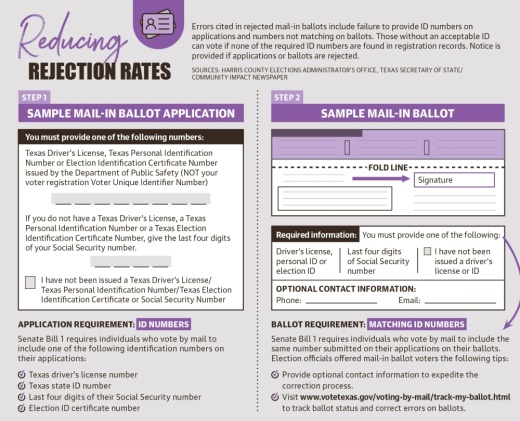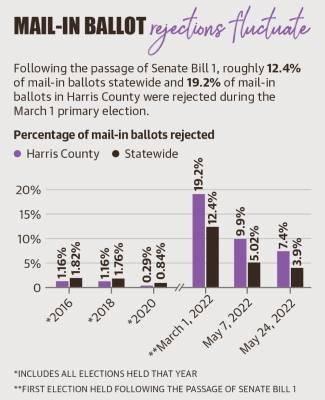The increased rejection rates were seen in elections held six to eight months after Senate Bill 1 added new voting requirements to Texas elections.
The number of mail-in ballots rejected in Harris County skyrocketed following the passage of SB 1 in September 2021, jumping from 135 mail-in ballot rejections during the Nov. 6, 2018, midterm election to about 6,900 rejected ballots in the March 1 primary election, according to Harris County Elections Administrator’s Office data.
Leah Shah, the director of communications and voter outreach for the Harris County elections administrator’s office, said the “historic rate” of mail-in ballot rejections was a big challenge for the county during the March and May primaries.
“There are new requirements under the law that require different information, including Texas ID or Social Security,” Shah said. “We found that a lot of people who were filling the forms out both for the application and the return ballot were missing those required fields, and that created a kind of a domino effect of rejections.”
Statewide, 24,636 mail-in ballots were rejected in the March 1 primary election—roughly 12.4% of all mail-in ballots submitted, according to state data. According to a 2021 U.S. Election Assistance Commission report, Texas rejected roughly 8,300, or about 0.8%, of the nearly 1 million mail-in ballots cast in the 2020 presidential election.
Although mail-in ballot rejections surged in March, in the two elections held since then, the number of rejected mail-in ballots declined, according to state data.
The new regulations surrounding mail-in voting are one of many laws included in SB 1, a voting reform bill that was approved by the Texas Legislature. Sam Taylor, assistant secretary of state for Communications, said he believes the decline in mail-in ballot rejection rates from March to May can be attributed to voters adjusting to the voting changes.
However, Taylor said the addition of reconciliation reports—which require counties to compare the number of voters who cast valid ballots with the number of votes counted by their tabulation system—has added a new layer of transparency.
“The reconciliation form that was added in SB 1 has been the biggest help for our office in terms of hunting down any issues that we see in the reporting of results,” Taylor said.
Since 2015, the state has successfully prosecuted 155 individuals for election fraud offenses, according to the Texas attorney general’s office. While the new voting-by-mail regulations were approved to reduce the potential for fraudulent voting, local election officials and policy experts said the regulations have added hurdles for individuals who vote by mail.
While the state and Harris County saw decreases in mail-in ballot rejections from March’s primary election to elections held in May, Renee Cross, senior director of the Hobby School of Public Affairs at the University of Houston, said she believes the effect of SB 1 might not be completely visible until the November election.
“Just like any primary election in Texas, voter turnout is relatively low,” Cross said. “I don’t think we’re going to see the full effect of these laws until you have a statewide general election, which of course we will have in November.”
Mail-in ballot rejections
To be eligible to vote by mail in Texas, state law dictates an individual must be age 65 or older, sick or disabled, out of the country, expected to give birth or confined to jail but otherwise eligible to vote.
Under SB 1, voters are required to provide a partial Social Security number or driver’s license number on their mail-in ballot applications to receive ballots. Once voters receive their ballots, they must include the same numbers used on their applications for the ballots to be counted.
Shah said even though the final number of mail-in ballot rejection rates was 19.2% for the March primary, the percentage of ballots flagged for rejection before being corrected was close to 90%. This meant added time and labor for county workers to help voters correct their ballots.
“That was a very big challenge and also very disheartening that voters weren’t able to have their votes counted,” Shah said. “We had to scale up both our mail ballot team and our call center team to handle the influx [of voter calls]. ... Because of the size of the county we were, we had the resources to scale up in that way, [but] a lot of counties don’t.”
Locally, during a May 7 election determining two commissioner positions for Harris County Emergency Services District No. 11—which provides emergency medical services across the majority of Spring and Klein—the winner of the last at-large position won by 84 votes. Of the 2,784 mail-in ballots sent in the contest, 484 ballots, or about 17.4%, were rejected.
Similarly, during a May 7 election for two commissioner positions for ESD 16—which provides fire suppression and rescue services in the western portion of the Spring area—126 mail-in ballots were rejected out of a total of 789, representing an almost 16% rejection rate.
Among the officials who encountered issues with the new mail-in ballot regulations was former Harris County Elections Administrator Isabel Longoria, who resigned from her position July 1 following challenges with mail-in ballots during the March 3 primary. Longoria’s position has since been filled by Clifford Tatum, who was sworn in Aug. 24, according to a news release from the elections administrator’s office.
On May 20—when Longoria was elections administrator—she said she saw many voters miss the new ID portion on their mail-in ballot due to a privacy flap on the form aimed at protecting voters’ ID numbers.
While the privacy flap is required by law, Taylor said after hearing feedback from counties that the ID portion of the ballot was being missed by voters, the state adjusted the ballot’s design ahead of the November election. Changes include an added red outline to the ID portion of the ballot so it would be more noticeable.
Additional barriers
Cross cited concerns that SB 1’s new ID requirements for mail-in ballots may be creating challenges for voters who are older.
“If someone is eligible to vote by mail, more than likely they’re ... over 65,” Cross said. “Well, they’re not going to remember what ID they used when they registered to vote 45 years ago. ... Things can make sense in terms of policy, but ... sometimes these things come up that you don’t foresee.”
Shah likewise said she was concerned about older voters as they learn about SB 1’s new voting requirements.
“[The changes] certainly impacted seniors [and] those with disabilities the most, ... especially in our senior population, where they’ve been told, ‘Don’t provide a Social Security number in the mail,’” Shah said. “[Voters wondered,] ‘Is this coming from Harris County? Or is this fraudulent mail?’ ... It’s counterintuitive to, I think, what seniors have been told not to do.”
Taylor said state officials have worked to address voters’ concerns and he believes many issues encountered during the March primaries have since improved.
Searching for solutions
Tatum will have only been in office for a little over two months when the November election is held, but he is working to ensure voters do not experience any major issues, according to an Aug. 24 news release from his office.
“I am reviewing and assessing the current election processes and procedures, and I am pleased to say that we are on track for a successful November election,” Tatum said in a statement. “I look forward to serving voters in Harris County and working alongside a very dedicated and professional team to ensure the Nov. 8 election runs smoothly.”
In preparation for Nov. 8, Shah said Harris County officials have launched an educational campaign and community outreach programs to educate voters. The county also added informational inserts to ballots to remind voters to fill out required fields and updated its voting resource website. Shah noted Harris County also has a call center staffed with dozens of people who can answer voters’ questions ahead of November.
“I anticipate [mail-in ballot rejection rates] will continue to go down,” Shah said. “But we are still pushing a lot more resources toward mail ballots than we ever have before.”
At the state level, officials are working to educate voters about the SB 1 ballot changes through measures such as an educational tour that has been held at community hubs across Texas.
“We are confident that [redesigning ballots and educational campaign efforts] in combination with more voter education and positive engagement from local election officials helped significantly reduce mail ballot rejection rates in both the May 7 and May 24 elections,” Taylor said.
Cross said while it is hard to determine whether mail-in ballot issues will persist, voter turnout during the March primaries suggests SB 1 may not lead to the voter suppression its opponents have feared.
“I think in some ways, just the added attention of new laws [in the media] and the threat that it could suppress voting ... actually had the opposite effect and made people turn out,” Cross said.
Rachel Carlton contributed to this report.








